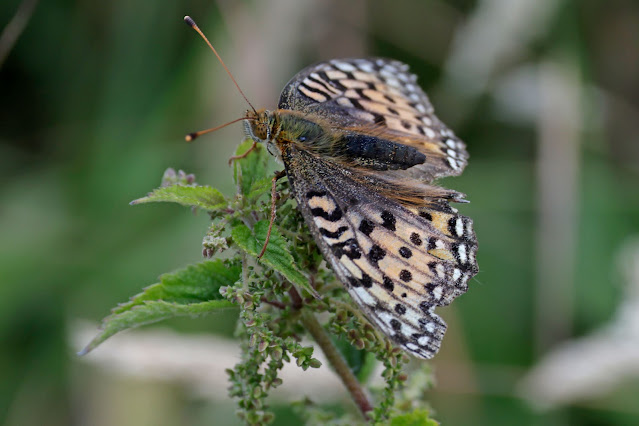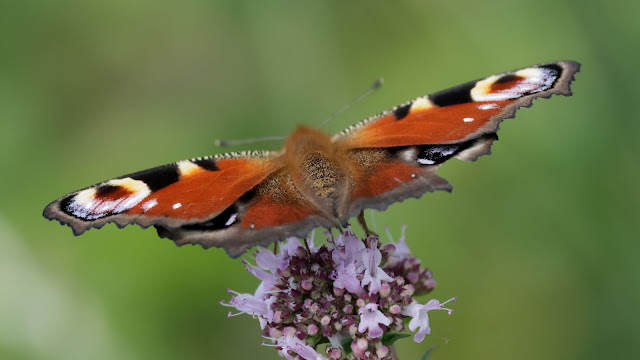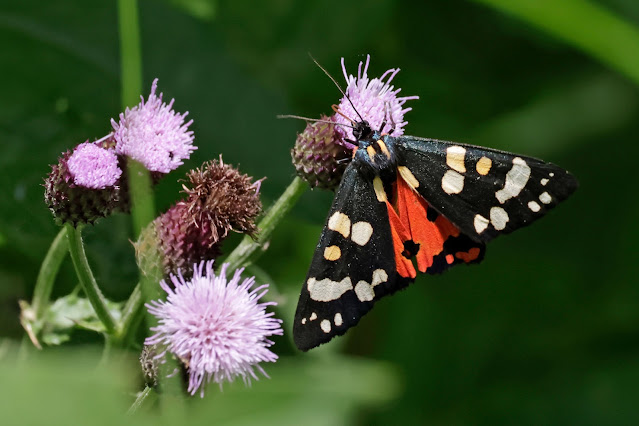A short drive to meet Ian this morning, staying in the village and meeting him at Swellinghill Pond. I arrived before him and nostalgically, took a walk around the pond. There were many white butterflies around the bramble bushes, nectaring on the flowers, mostly Small and Large White butterflies, they were easy to photograph. A Large White
We were here for Ian to see the Violet Helleborines, whilst they had grown since I last saw them they were still not in flower. The flower spikes curving over, hopefully once they do there will be a good show
Back at the pond there were some more butteflies on the bramble.
And a Peacock that are now emerging as a second brood.
We then set off for Greywell Moors, a small reserve just outside Odiham, there was a stop in Alton along the way but we arrived at the Pumping Station. We had to climb the gate and then walked through the long grass towards the hedge alongside the stream. A Small Skipper showing well on a leaf.
We were here for a special orchid, we had seen them last year but came a little later in July. The word was that they were flowering now and it didn't take long to find the Marsh Helleborine.
A stunning orchid of wetland areas, the Marsh helleborine
can be found in fens, damp grassland, marshes and dune slacks, particularly on
chalky soils. Its rather loose flower spike carries up to twenty white-and-pink
flowers during July and August; in some areas, forests of hundreds of plants
can colour the green marsh vegetation, which was very much the case here at
Greywell. But despite its profusion in places, the Marsh helleborine is
declining due to habitat loss.
The Marsh helleborine has broad, oval leaves at the base of
the stem, and narrower leaves higher up the reddish stem. The flower spike
consists of a loose cluster of white flowers that have a white, frilly lip and
reddish sepals which look like wings; they hang on reddish stalks.
For me the Bee and Fly orchids are amazing but I find the Marsh Helleborine very special, a real looking orchid. It also bizarrely reminds me of the Stinky Pete character from Toy Story 2. Check it out!
In amongst the forest of Marsh Helleborines were Southern Marsh Orchids and Marsh Fragrant Orchids. These are Southern Marsh Orchids.
There were plenty of butterflies about, here a Marbled White on the thistle flower head.
A Red Kite drifted over, but I was distracted by a butterfly settled on the Hemp Acrimony. Using the binoculars I focused on it and could see it was a Hairstreak and went for Brown.
We defaulted to Brown Hairstreak, but it wasn't until Ian had a closer look that we realised it was actually a White-letter Hairstreak, the Brown Hairstreak has two white lines on the underside, this had a distinctive "W" shaped white lines.
Looking around the area we could only find one tall Wych Elm, plus it was now almost mid day and they are usually in the top of the trees at this time, only coming down early morning and late afternoon.
It very kindly flew to a flower head in much better light and allowed some great shots.
Normally they are way up in the trees and all you get is a distant view and photograph. Here I can get a close up on the insect.
It finally flew off and lost to view. We returned to the orchids and had the surprise of a Small Skipper on a Marsh Fragrant Orchid.
Of interest was this wasp nectaring on the Marsh Helleborine flowers, note the pollen sack on the head of the wasp, job done for the orchid.
A Red flash alerted me to a moth again nectaring on the many flowers. A closer look revealed it to be a Scarlet Tiger.
We walked around the open area where there were many butterflies. A nice Common Blue, probably just emerged from a second brood.
At the back of the reserve there was a group of Reedmace, the area though completely dry, testimony to the dry weather we have had. In the small willow bushes growing amongst the reedmace was a Sedge Warbler.
Walking back, we met another visitor and he was able to help us with some of the orchid identification struggles. He pointed out the the white form of the Marsh Helleborines, which we hadn't noticed as we walked around the many plants.
In the pale-flowered Marsh Helleborine variation epipactis
palistris ochroleuca, the yellow-white toned flower is almost devoid of red
and the three sepals are mostly a greenish-yellow. The hairy stems are likewise
less reddish and more green. This variation is more often likely found in
coastal dune systems than the fenland found here.
It would be a miss to have not shown the Marsh Fragrant Orchids. Marsh Fragrant Orchid occurs only in alkaline marshy
ground fed by calcareous water. It is thus more distinguishable from the
two other British fragrant species on grounds of habitat rather than
significant physical features.
The plants here appeared quite similar to the
closely related Chalk Fragrant species, and seemed to confuse some of the identification
apps. The spikes are said to be more tightly packed, and there can be up to 100
flowers in shades of pink on the tallest stems (up to 70 cm) from late June to
August. However it seems it is very difficult to separate reliably as the Marsh
Fragrant without DNA analysis being employed, we were happy though to take the
comments of the visitor we met
As we left another Scarlet Tiger was settled on the Hemp Acrimony.
From Greywell we headed south on the M3 to Magdalen Hill, a reserve just outside Winchester. It was warm and we fancied a butterfly afternoon, with the chance of getting another early emergence.
We walked through the large flower meadow in overcast conditions with few butterflies about, but as soon as the sun came out they were everywhere, Small and Large Whites flying over the flowers, Meadow Browns weaving amongst the grass stems and Marbled whites cruising around the knapweed.
Getting onto the slopes there were Gatekeepers around the hawthorn and bramble.
The view looking south across the farmland.
A skipper low down in the grass had some dark black clubs on the end of the antennae, an Essex Skipper.
There were plenty of Brown Argus zipping around the slopes, but a few did settle when the sun went in.
As we came down the slope toward the bottom, a pale blue butterfly passed us and settled on a dead yellow rattle stem.
Then came to the thyme bushes to nectar, a Chalkhill Blue, the butterfly we had hoped to see this afternoon.
It even graced us with open wings, showing the lovely pale blue, contrasting with the grey tips and edges.
Walking on a nice view of a Small Skipper head on.
And around the thyme a tiny Mint Moth.
Another nice Small Skipper
Walking back towards the cars, a Crab Spider, feeding on an insect on a Field Scabious
A great day, with some surprises.
















































































